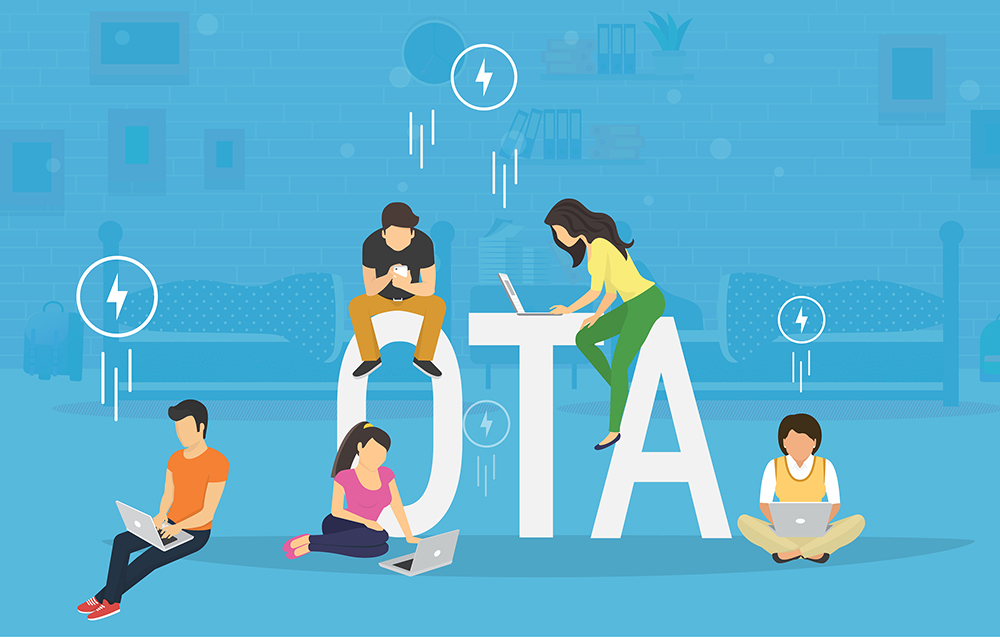
Schools and universities with storied hallways were not built to meet the power demands of today’s tech-dependent world. When it comes to the management of these buildings, many obstacles prevent seamless operations: architectural or design limitations, costly maintenance, and the complex needs of the modern academic landscape. These obstacles cannot simply be resolved by longer-lasting batteries or the installation of more electrical outlets.
Over-the-air (OTA) power is the emerging technology that may provide the solution. Utilizing OTA power would allow every device within the facility—such as a student or staff’s cell phone, an HVAC sensor, or a smoke alarm—to receive power simultaneously and continuously without the need to install electrical conduits. Just as Wi-Fi revolutionized Internet access, so will OTA power revolutionize energy access.
What is OTA Power?
OTA technology transmits power from “point A” to “point B” without any wires or physical induction pads in between. Imagine being able to charge your cell phone in your purse or pocket from a power source in the ceiling, as you walk around the room. The device receiving power is not connected to any electrical outlet, nor is the user required to leave it on a charging pad. OTA power utilizes a transmitter that sends power through the air, traveling by way of radio waves, to a receiver that is installed within the device. The transmission can power any OTA-compatible electronic device within a specific radius. The concept is similar to how a Wi-Fi router provides Internet access to cell phones and laptops. With OTA power, any device that can connect to the transmitter will be able to be powered or charged wirelessly.
Challenges Facilities Face with Power
Modern power distribution and electrification create considerable challenges when access requirements need to be balanced with architectural design elements and limitations. For existing structures, buildings are either limited by the electrical access points already incorporated or require costly modifications to the entire system. Rooms need to be carefully laid out and wired around where the equipment is going to be placed and used. Because of this, spaces such as libraries and computer and science labs are especially difficult to power.
The complexity associated with rewiring means that entire sections or buildings need to shut down while this work is being done, which negatively impacts students and faculty alike. When one building closes, the traffic of the remaining buildings increases, creating a higher power demand on limited access points. Even after an upgrade of a building’s electrical system is implemented, it may not be a long-term solution.
As personal and organizational energy demands increase—along with the student body—those upgrades to the entire facility have a limited shelf life before the entire process has to be repeated. Future-looking technologies such as OTA power can help overcome some of these challenges by creating nearly universal access to power that does not require a physical overhaul of a building or the entire campus.
How OTA Power Will Benefit Educational Facility Management
The potential effects of OTA power within educational facilities is significant. Since OTA transmitters do not require any change to a building’s preexisting electrical infrastructure, educational institutions will be able to bypass expensive and time-consuming construction projects with a more effective plug-and-play solution. This approach will instantly impact how spaces within a facility can be used and how, for example, smart building sensors can be deployed. Rather than being limited in design by proximity to an outlet, classrooms, libraries, and labs can be designed around the most effective intended use of the space.
Overall, there will also be fewer wires, creating fewer instances of electrical or aesthetic issues. With OTA power access points everywhere, buildings will become future-proof, regardless of their age. As educational equipment continues to advance, there will be no need to constantly shift the way these devices are powered or where they are positioned. The access to power will always be there in the air. Similarly, as class and faculty sizes grow, the extra burden of where to plug in a laptop or charge a phone will become almost nonexistent. Every student, faculty, and staff member will have access to the power they need without putting an increased burden on facility operators.
Internet of Things (IoT) sensors are increasingly becoming commonplace in educational facilities as a means to improve energy efficiency and safety. But currently, the places where such sensors can be installed are limited by access to power and cost of wiring or the need for frequent battery replacement. OTA power will eliminate these limitations. Facility managers may install sensors almost anywhere, with no concern about wire harness installation or frequent battery maintenance, ultimately saving on total cost of ownership and reducing energy consumption. For example, security cameras and smoke alarms will have the ability to charge with OTA power. Buildings will also be capable of quickly accommodating new technologies, such as AI-enabled motion detectors, sound detectors, and heat detectors.
OTA power can help facilitate the transition of older buildings to meet the demands of our modern society of gadgets and gizmos. It will help save money and time on facility upgrades. It will eliminate the need for major renovations to accommodate energy demands. This emerging technology will quickly modernize outdated educational facilities to become compatible with the technological advancements that students, faculty, and facility operations of the future will require.
Behrooz Abiri is cofounder and CTO of GuRu Wireless, Inc., located in Pasadena, CA. He can be reached at [email protected]. This is his first article for Facilities Manager.
Power Tools
Seeks to engage multiple voices from among FM ranks to bring fresh insight and real knowledge from the trenches on what’s working in planning and implementation for energy-related projects and innovations. To contribute, contact [email protected].
See all Power Tools.


